|
Related FAQs: Soft Corals of the Family Alcyoniidae,
Alcyoniids 2, Alcyoniids 3, Alcyoniids 4, Alcyoniid ID, Alcyoniid Selection, Alcyoniid Compatibility, Alcyoniid Systems, Alcyoniid Feeding, Alcyoniid Behavior, Alcyoniid Health,
Alcyoniid Disease 2,
Alcyoniid Disease
3, Alcyoniid Disease 4,
Alcyoniid Disease 5, Alcyoniid Disease 6, Alcyoniid Disease 7, Alcyoniid Disease 8, Alcyoniid Disease 9, Alcyoniid Health 10, Alcyoniid Disease 11, Alcyoniid Health 12, Alcyoniid Disease 13, Alcyoniid Disease 14, Alcyoniid Disease 15, & Alcyoniid
Propagation, Soft Coral Propagation,
Soft Coral Health, Dyed Corals,
Related Articles: Soft Corals,
Order Alcyonacea,
/The Best Livestock For Your Reef Aquarium:
Soft Corals of the Family Alcyoniidae,
pt. 1
To: Part
2,
Part 3,
Part 4, Part 5,
Part 6
|
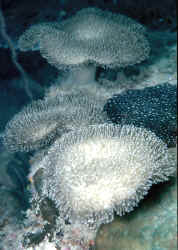
|
|
By Bob Fenner
|
Sarcophyton
|
Most of the commonly offered species require strong water movement,
good lighting, frequent water changes, excellent skimming... and
occasional vitamin soaked faux plankton feeding to excel. Genera, species are
identified by sampling, sorting small internal hard sclerite parts; as to shape,
size, preponderance... Hence, as always, my IDs here are tentative (at best).
Genus Alcyonium: Dead Man's Fingers, Hand Corals. Cold water
species.
| Alcyonium sp. Coldwater species from the N. Atlantic. |
|
Genus Cladiella: Cauliflower, Tree Leather Coral. Knobby lobes on
stalks that are low, hard to make out. Small, uniform polyps can quickly
withdraw into the surface.
| Cladiella sp. Common, but never abundant
where found in the Indo-Pacific. Not as easily kept as the more
common Alcyoniids, not easily fragment reproduced. Notable for
their knobbiness and capacity to change color quickly when touched. Right; a
colony in Fiji. Below: The same "Normal" and
"touched" colony off of Queensland, Australia. |
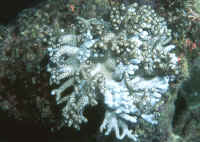
|
| Cladiella sp. Knobby lobes on stalks that
are low, hard to make out. Small, uniform polyps can quickly
withdraw into the surface. N. Sulawesi, Indo. |
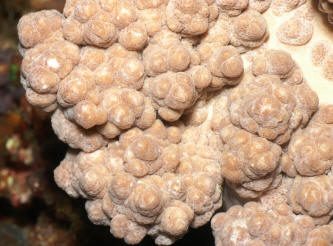
|
| Cladiella pachyclados, Red Sea
close-up by Diana Fenner. |
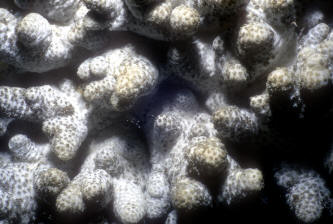
|
Genus Klyxum: /wiki:
is a genus of
animals in the family Alcyoniidae.[1][2] They
are commonly called cauliflower
colt coral,
or simply colt
coral.
These common
names can
also refer to the related genus Cladiella.
Genus Lobophytum Marenzeller 1886: Finger Leather, Soft
Coral. Colonies up to 2 meters across. Usually low, creeping...
lumps/folds/ridges, lobes... and vary in color... I may very well confuse this
soft coral genus w/ Sinularia, others. Surface covered with TWO dissimilar
(dimorphic) polyps that are retractable: Larger (0.5 mm) ones called autozooids
and tinier siphonozoids that lack tentacles (and dot the surface)
| Lobophytum spp. Common throughout its range
in the Indo-Pacific. Feed via photosynthesis and plankton. Grow in
folds or finger-like projections by folding coenenchyme. Sulawesi,
Fiji and Philippines images first row below. Second row: an usually
large "patch" of colonies on the reef lip (at the top of
the slope), and two close-ups in the Red Sea. |
Bigger PIX:
The images in this table are linked
to large (desktop size) copies. Click on "framed" images
to go to the larger size. |
|
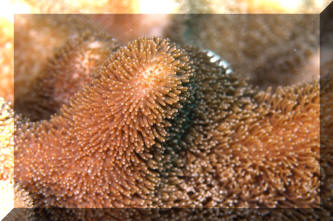
|
| Lobophytum sp. Indo-Pacific Sea Hand. to
about six inches. Needs dim light, to be fed planktonic food at
night. Looks like a lump by day, with enlargement, extension of
elongated, clear polyps by night. Two pix from Fiji at night. |
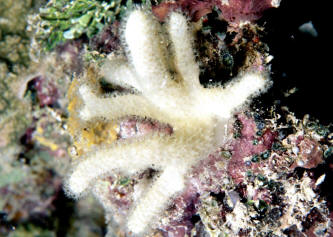
|
Bigger PIX:
The images in this table are linked
to large (desktop size) copies. Click on "framed" images
to go to the larger size. |
|
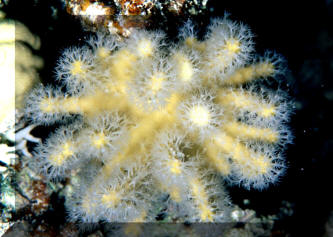
|
| Lobophytum sp. (4...). Lobed Leather Coral.
Made of several robust lobes, closely-set. Greenish to yellowish
brown in color. Melanesia. N. Sulawesi pic. |
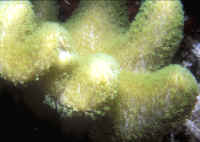
|
| Lobophytum pauciflorum (Ehrenberg 1852), Devil's Hand
Soft Coral. Indo-West Pacific, including the Red Sea. Low stalked w/ large
capitulum (head). Numerous (yellowish) polyps, increasing on lobe ends.
Large grey/yellow colonies; common in shallows, reef slopes. Red Sea 2019. |
%20MD.JPG)
|
Bigger PIX:
The images in this table are linked
to large (desktop size) copies. Click on "framed" images
to go to the larger size. |
|
%20MD.JPG)
|
Bigger PIX:
The images in this table are linked to large (desktop size) copies.
Click on "framed" images to go to the larger size. |
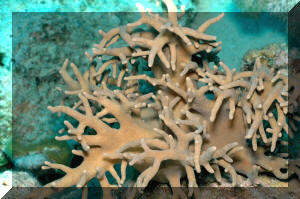
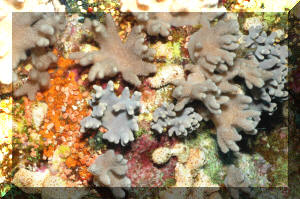
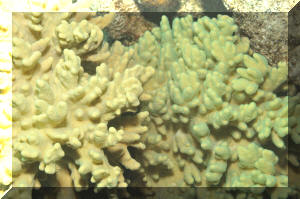
MD.JPG)
%20MD.JPG)
%20MD.JPG)
%20crop%20MD.jpg) |
To: Part
2,
Part 3,
Part 4, Part 5,
Part 6
|
|

